1. First traces of the pointed arch employed in Italy, in the chapel of St. Laurence at Subiaco; see pl. 35, figs. B, E, F, no. 4.
2. The same form of arch, from the Church of Sta. Scholastica at Subiaco; tenth to eleventh centuries; see pl. 35, figs. K, L.
3. Similar kind of arch in the cloister from the same; see pl. 35, figs. M, N, O, P.
4. Mixture of two kinds of arches from the Cathedral of Modena; the longitudinal section shows only semicircular arches, in the transverse section is seen the pointed arch of the nave, introduced at the time of a restoration in the eleventh or twelfth centuries; the plan and section of this church are given at pl. 73/16, 30, 39, 40, and 42; one of the columns, pl. 68/28; and a capital, pl. 70/12.
5. The pointed arch of the nave of the Cathedral of Chiaravalle, the windows have semicircular arches; twelfth century; see pl. 73/17, 31, 41, 43; pl. 64/13; pl. 68/33, for the columns; pl. 70/10, 11, for the bases.
6. This mixture of the two kinds of arches is also observed in Sta. Maria in Castello at Corneto; twelfth century; see pl. 73/48, and pl. 64/14.
7. The pointed arch alone, in the Church of St. Francis at Assisi, thirteenth century; see pl. 36 and 37.
8. Another mixture of the two kinds of arches at St. Etienne du Mont, Paris; the lower arches are segmental, the pointed arches restorations in the thirteenth century; see pl. 73/46, 53.
9. The round arch placed above the pointed in the Church of St. Flavian, of the eleventh and twelfth centuries; see pl 38.
10. Alternate employment of the two kinds of arches in the Cathedral of Siena, according to the period or taste of the architects engaged in its construction, in the thirteenth century. Consult for the dates of these constructions the work of P. Guglielmo della Valle, entitled Lettere Sanesi, 3 vols. in 4to.; Venezia et Rome, 1782, 1786, vol. i, p. 1777. The general plan and sections of the Cathedral of Siena are engraved in pl. lxxiii, no. 49.
11. Similar combination from the Cathedral of Orvieto in the thirteenth century; for plan and sections of this church see pl. lxxiii, no. 50; the fašade, pl. lxx, no. 18; bases and capitals of the columns of nave, pl. lxx, no. 26; and see further Storia del duomo di Orvieto; Roma, 1791, in 4to. fig., by the Padre della Valle.
12. The pointed arch, employed throughout the Church of Sta. Maria del Fiore at Florence, commenced in 1298, from the design of Arnolfo de Lapo; see for plans and sections, pl. 73/52; the cupola, pl. 67/16; one of the pilasters, pl. 70/24, 25.
13. The pointed arch employed with arches of other curves at the Alhambra; see pl. 44.
14. Springing of an arch from an ancient church in Paris, at Capo di Bove, near Rome; thirteenth century; for the sections of this church see nos. 16 and 17; and the plan 36/18.
15. Detail of one of the windows from the same church.
16. Transverse section of the church at Capo di Bove.
17. Longitudinal section of the same.
18. Four centered arches, employed in England from the eleventh to the fifteenth centuries.
19. Entrance of the Curch of St. Laurence at Naples, constructed in the thirteenth century by Maglione, pupil of Nicolas of Pisa.
20. Elevation of the small Church of Sta. Maria in Acumine at Rimini, built in 1373.
21. Side elevation of the same church; the arches of the interior are pointed, the exterior is constructed in brick, with ornaments in terra cotta.
22. The irregular employment of the two kinds of arches in the Church of Sta. Maria sopra Minerva at Rome; fourteenth century; for plan and section of this church see pl. 73/75, and one of its columns, pl. 68/53.
23. Pointed arch, from the Cathedral of St. Francis at Rimini; fifteenth century; the plans and details of this church are engraved at pl. 51.
24. The round arch substituted for the pointed in the church of St. Augustine at Rome, from the design of Baccio Pentella, and the end of the fifteenth century; plan and sections of this church are seen at pl. lxxiii, no. 61; and details of the interior, pl. 70/36.
25. Another example of Round arch, in the Loggia or Portico de' Lanzi, on the place of the old palace at Florence, built in the fourteenth century by Andrea Orcagna; one of the pillars is given pl. 68/50; the base and capital, pl. 70/27.
| |

|
